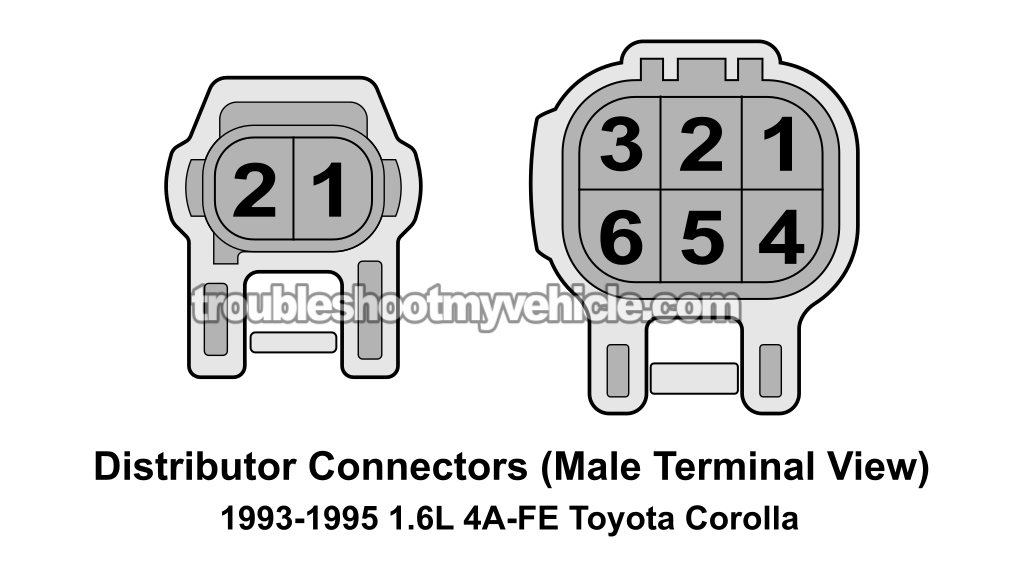
The distributor pickup coil generates the crankshaft position and RPM signal that the fuel injection computer needs to activate the ignition coil (via the igniter) and enable the fuel injectors and fuel pump.
Eventually, the distributor pickup coil's gonna fail. When that happens, the engine won't start.
In this tutorial, I'll walk you through my method of testing the pickup coil to see if it's the reason your engine won't start. With your test results, you'll easily find out if the igniter is good or bad.
Contents of this tutorial:
- What Does The Distributor Pickup Coil Do?
- Symptoms Of A Bad Pickup Coil.
- Distributor Connector Circuit Descriptions.
- Where To Buy The Distributor Pickup Coil.
- TEST 1: Checking The Pickup Coil's Resistance With A Multimeter.
- TEST 2: Testing The Pickup Coil's Output With A Multimeter.
- More 1.6L Toyota Corolla Tutorials.
APPLIES TO: This tutorial applies to the following vehicles:
- 1.6L (4A-FE) Toyota Corolla: 1993, 1994, 1995.
Ignition System Tests:
- How To Test The Ignition Coil (1993-1995 1.6L Toyota Corolla).
- How To Test The Igniter (1993-1995 1.6L Toyota Corolla).
Ignition System Wiring Diagram:
Engine No-Start Diagnostics:
What Does The Distributor Pickup Coil Do?
Here's what you need to know about the pickup coil before we dive into testing:
- Two sensors in one: The distributor pickup coil isn't just one sensor —it's actually two packed into a single assembly, producing two separate AC voltage signals:
- G1 signal: This acts as the crankshaft position (CKP) signal.
- NE signal: This works as an RPM reference signal.
- Magnetic sensors: The G1 and NE sensors are magnetic sensors that detect their corresponding reluctor wheels (toothed wheels attached to the distributor shaft).
- Signal generation: As the engine cranks or runs, the reluctor wheels spin along with the distributor shaft. Their teeth pass by the magnetic sensors, creating two AC voltage signals —G1 and NE.
- G1 signal: Tells the fuel injection computer the crankshaft's position.
- NE signal: Works as an RPM signal, feeding the computer critical engine speed data.
- Spark control and ignition timing: The fuel injection computer reads these AC signals to determine when to fire the ignition coil through the igniter (ignition control module).
- The ignition coil then generates a high-voltage spark, which travels through the distributor cap, rotor, and spark plug wires to the correct spark plug.
Symptoms Of A Bad Pickup Coil
A bad pickup coil can cause engine performance issues, making it hard to start or even shutting the engine off unexpectedly. The two most common symptoms are:
- Engine won't start:
- The igniter doesn't get its IGT activation signal.
- The igniter fails to trigger the ignition coil.
- The fuel injection computer doesn't enable the fuel injectors.
- The fuel injection computer doesn't activate the fuel pump.
- Rough running or sudden stalling:
- The engine might misfire, run unevenly, or shut off without warning while driving.
- Ignition system trouble codes:
- Code 12: G and NE Signal Problem.
- Code 13: NE Signal Circuit Problem.
Distributor Connector Circuit Descriptions

Your 1.6L Toyota Corolla's distributor has two connectors. One is a 2-wire connector, and the other is a 6-wire connector.
NOTE: The wire colors in the tables below match the engine wiring harness connectors, not the ones directly on the distributor.
Here's what each connector's circuits do:
2-Wire Connector:
| Pin | Wire Color | Description |
|---|---|---|
| 1 | Black with orange stripe (BLK/ORG) | B+ → Ignition 12 Volts |
| 2 | Black (BLK) | IG- → Tachometer Signal |
6-Wire Connector:
| Pin | Wire Color | Description |
|---|---|---|
| 1 | Black (BLK) | IGT → Ignition Timing Signal |
| 2 | White (WHT) | NE- → Sensor Ground For NE |
| 3 | Green (GRN) | G- → Sensor Ground For G1 |
| 4 | Black with yellow stripe (BLK/YEL) | IGF → Ignition Feedback Signal |
| 5 | Black (BLK) | NE → Engine Speed Signal |
| 6 | Red (RED) | G1 → Crankshaft Position Signal |
NOTE: The distributor engine wiring harness connector has female terminals. The connector coming out of the distributor itself has male terminals.
Where To Buy The Distributor Pickup Coil
The pickup coil isn't sold separately from the distributor, so if your test results indicate it's bad, you'll need to buy the entire distributor.
Disclosure: As an Amazon Associate, I earn from qualifying purchases. If my tutorials help you, using these links is an easy way to support the site at no extra cost to you. Thank you!
NOTE: Not sure if the distributor fits your particular Corolla? Don't worry. Once you get to the site, they'll ask you for the specifics of your vehicle. If it doesn't fit, they'll find you the right one.
TEST 1: Checking The Pickup Coil's Resistance With A Multimeter

The most common type of failure that the G1 or NE sensor experiences is an internal short-circuit or open-circuit problem.
To check if the NE and G1 sensors have an internal electrical issue, we can use a multimeter set to Ohms (Ω) mode to measure their resistance and see if it's within specification.
If the NE and G1 circuits are in good shape (meaning no internal shorts or open-circuits), the multimeter should show these resistance values:
- G1 Sensor: Between 185 and 265 Ohms (engine cold).
- NE Sensor: Between 185 and 265 Ohms (engine cold).
NOTE: These resistance tests are done on the distributor's 6-wire connector —the one directly on the distributor, which has male spade terminals.
Let's jump in:
- 1
Unplug the distributor's 6-wire connector from the engine wiring harness.
- 2
Switch your multimeter to Ohms mode.
- 3
Check the resistance between terminals 2 and 5 on the pickup coil connector.
These terminals belong to the NE sensor. - 4
Your multimeter should show 185-265 Ohms.
- 5
Now, measure the resistance between terminals 3 and 6 on the pickup coil connector.
These terminals belong to the G1 sensor. - 6
Your multimeter should again read 185-265 Ohms.
Let's break down your test results:
CASE 1: The NE and G1 sensor resistance is within range. This result confirms the pickup coil doesn't have an internal electrical issue.
You don't have to, but if you want extra confirmation (that the sensors are OK), you can check to see if they're actually generating a signal in TEST 2: TEST 2: Testing The Pickup Coil's Output With A Multimeter.
CASE 2: The NE and G1 sensor resistance is NOT within range. This confirms the pickup coil is bad and needs to be replaced.
Since the pickup coil assembly isn't sold separately, you'll have to replace the entire distributor.
Again, it's not required, but if you want to double-check, you can perform TEST 2. Go to: TEST 2: Testing The Pickup Coil's Output With A Multimeter.
TEST 2: Testing The Pickup Coil's Output With A Multimeter

When the engine cranks, the G1 and NE sensors in the pickup coil assembly produce an AC voltage. You can easily test them with a multimeter set to Volts AC mode.
- Good G1 or NE sensor: While the engine is cranking, your multimeter should read between 0.4 and 1.2 Volts AC for each sensor.
- Bad G1 or NE sensor: If a sensor has failed, the multimeter will show 0 Volts AC while cranking.
NOTE: The AC voltage output depends on how fast the engine cranks, which is directly affected by the battery's charge. For the most accurate results, make sure your Corolla's battery is fully charged before running this test. If it's low, charge it first.
Alright, let's get started:
- 1
Unplug the distributor's 6-wire connector from the engine wiring harness.
- 2
Set your multimeter to Volts AC mode.
- 3
Use your multimeter's test leads to probe male spade terminals 2 and 5 on the 6-wire distributor connector.
Terminals 2 and 5 belong to the NE sensor.
NOTE: Make sure you're probing the male spade terminals on the distributor's connector, not the female terminals on the engine wiring harness connector. - 4
Have a helper crank the engine while you watch the multimeter.
CAUTION: Be careful while the engine is cranking. - 5
Your multimeter should show an AC voltage fluctuating between 0.4 and 1.2 Volts AC for the NE sensor.
- 6
Now, probe male spade terminals 3 and 6 on the 6-wire distributor connector.
Terminals 6 and 5 belong to the G1 sensor.
NOTE: Again, make sure you're probing the male spade terminals on the distributor's connector, not the female terminals on the engine wiring harness connector. - 7
Have your helper crank the engine while you watch the multimeter.
CAUTION: Stay alert and be careful while the engine is cranking. - 8
Your multimeter should show an AC voltage fluctuating between 0.4 and 1.2 Volts AC for the G1 sensor.
Now, let's break down your test results:
CASE 1: The multimeter shows the expected AC voltage for both sensors. This confirms that the G1 and NE sensors in the pickup coil assembly are working properly.
CASE 2: The multimeter reads 0 AC voltage for one or both sensors. This means the pickup coil assembly is bad and needs to be replaced.
More 1.6L Toyota Corolla Tutorials
You can find a complete list of 1.6L Toyota Corolla tutorials and wiring diagrams in this index:
Here's a sample of the tutorials you'll find there:
- How To Test The Throttle Position Sensor (1989-1997 1.6L Toyota Corolla).
- How To Test Engine Compression (1989-1997 1.6L Toyota Corolla).
- How To Test The Fuel Injectors (1993-1997 1.6L Toyota Corolla).
- How To Do A Cylinder Balance Test (1989-1997 1.6L Toyota Corolla).

If this info saved the day, buy me a beer!



